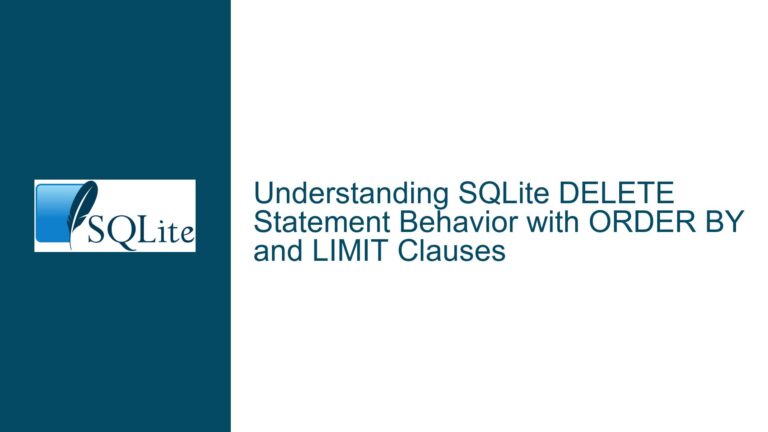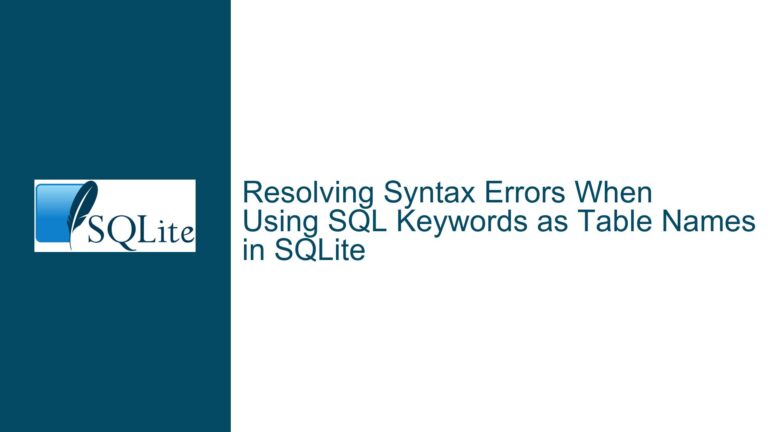SQLite HEX Function Behavior with NULL Input
HEX Function Returns Empty String Instead of NULL
The behavior of the HEX() function in SQLite when provided with a NULL input has been a point of confusion for many developers. Specifically, the function returns an empty string rather than NULL, which is contrary to the behavior of many other SQLite functions. This behavior is documented, but it raises questions about consistency and the underlying design principles of SQLite’s function handling.
The HEX() function is designed to interpret its argument as a BLOB and return a string that represents the hexadecimal rendering of that BLOB’s content. When the input is NULL, the function returns an empty string. This is different from other functions like ABS(), which return NULL when given a NULL input. The discrepancy arises from the fact that HEX() is a string-valued function, and SQLite’s design philosophy for such functions is to always return a string, even when the input is NULL.
This behavior can be particularly problematic in scenarios where the distinction between NULL and an empty string is crucial. For example, if a column has a NOT NULL constraint, inserting the result of HEX(NULL) will not violate the constraint because the function returns an empty string rather than NULL. This can lead to subtle bugs if the developer expects NULL to propagate through the function.
NULL Interpretation in String-Valued Functions
The core of the issue lies in how SQLite interprets NULL in the context of string-valued functions. In SQL, NULL represents the absence of a value, and most functions propagate NULL when given a NULL input. However, SQLite’s HEX() function deviates from this norm by returning an empty string. This behavior is rooted in the function’s documentation, which states that it interprets its argument as a BLOB and returns a hexadecimal string representation of that BLOB.
The HEX() function’s documentation explicitly mentions that it interprets its argument as a BLOB, which is a key distinction. Unlike other string functions like SUBSTR(), which operate on strings and return NULL when given a NULL input, HEX() is designed to handle BLOBs. Since a BLOB can be zero-length, the function treats NULL as a zero-length BLOB and returns an empty string.
This interpretation is consistent with the function’s design but inconsistent with the behavior of other SQLite functions. For example, the ABS() function, which is not a string-valued function, returns NULL when given a NULL input. This inconsistency can be confusing for developers who expect uniform behavior across all functions.
The behavior of HEX() can be contrasted with that of SUBSTR(), another string function in SQLite. The SUBSTR() function returns NULL when given a NULL input, as it operates on strings rather than BLOBs. This difference highlights the importance of understanding how SQLite interprets NULL in different contexts.
Workarounds and Best Practices for Handling NULL in HEX Function
Given the behavior of the HEX() function, developers need to be aware of how to handle NULL inputs effectively. There are several workarounds and best practices that can be employed to ensure that NULL values are handled correctly in queries involving the HEX() function.
One common approach is to use the CASE statement to explicitly check for NULL values before applying the HEX() function. For example:
SELECT CASE WHEN x IS NULL THEN NULL ELSE HEX(x) END FROM table;
This approach ensures that NULL values are propagated correctly, rather than being converted to empty strings.
Another approach is to use the IIF() function, which is available in newer versions of SQLite. The IIF() function allows for a more concise expression of the same logic:
SELECT IIF(x IS NULL, NULL, HEX(x)) FROM table;
This approach is functionally equivalent to the CASE statement but is more compact and easier to read.
It is important to note that the following expression will not work as intended:
SELECT CASE x WHEN NULL THEN NULL ELSE HEX(x) END FROM table;
This is because the CASE statement in SQLite does not handle NULL values in the way one might expect. The CASE statement uses the IS operator internally, so the correct way to check for NULL is to use IS NULL explicitly.
In addition to these workarounds, developers should consider the broader implications of using the HEX() function in their queries. If the distinction between NULL and an empty string is important, it may be necessary to explicitly handle NULL values at the application level. This can involve additional checks and logic to ensure that NULL values are treated consistently throughout the application.
Another best practice is to document the behavior of the HEX() function clearly in the codebase. This can help prevent confusion and ensure that other developers are aware of the function’s behavior when working with NULL values. Additionally, developers should consider writing unit tests to verify that NULL values are handled correctly in queries involving the HEX() function.
In summary, while the behavior of the HEX() function in SQLite may be unexpected, there are several workarounds and best practices that can be employed to handle NULL values effectively. By using CASE statements, IIF() functions, and explicit NULL checks, developers can ensure that NULL values are propagated correctly and that the distinction between NULL and empty strings is maintained. Additionally, clear documentation and thorough testing can help prevent issues related to the HEX() function’s behavior.






